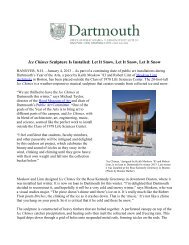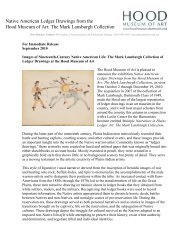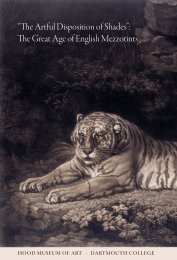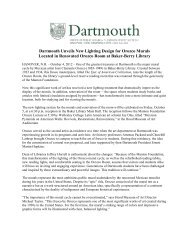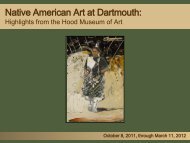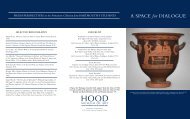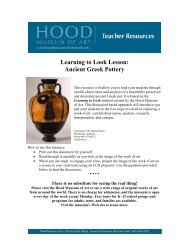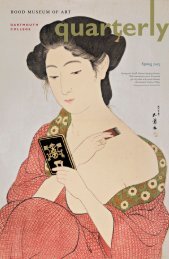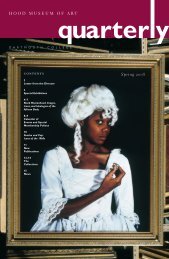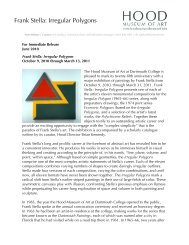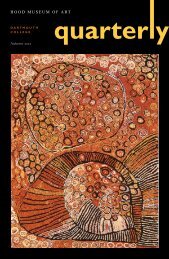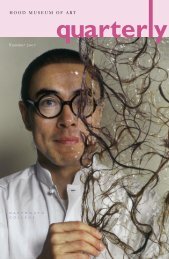Summer 2012 - Hood Museum of Art - Dartmouth College
Summer 2012 - Hood Museum of Art - Dartmouth College
Summer 2012 - Hood Museum of Art - Dartmouth College
You also want an ePaper? Increase the reach of your titles
YUMPU automatically turns print PDFs into web optimized ePapers that Google loves.
evading responsibility. Just one more<br />
plastic bottle, we say, but Jordan forces us<br />
to be accountable by confronting us with<br />
a defiled monument <strong>of</strong> our collective<br />
action.<br />
If you had to pick one photograph in<br />
the show to discuss in terms <strong>of</strong> its subject<br />
and its reference to an important<br />
environmental issue, which one would<br />
it be?<br />
An image <strong>of</strong> a high-density cattle ranch<br />
in Brazil, Daniel Beltrá’s Agua Boa,<br />
Mato Grosso (Brasil) (2008) stands out as<br />
a sharp reminder <strong>of</strong> the complex dimensions<br />
<strong>of</strong> environmental issues. We usually<br />
think <strong>of</strong> logging as the main cause <strong>of</strong><br />
deforestation, but in fact some 70 percent<br />
<strong>of</strong> illegal deforestation in the Brazilian<br />
Amazon is caused by the clearing <strong>of</strong> land<br />
for cattle ranching. This is in turn related<br />
to the Brazilian government’s devaluation<br />
<strong>of</strong> its currency in 1999, which greatly<br />
increased the competitiveness <strong>of</strong> Brazilian<br />
beef in the world market. Such cattle<br />
farms are also notorious for human rights<br />
violations, including the use <strong>of</strong> slave and<br />
child labor.<br />
Ian Teh, Kuye River, 2009, chromogenic print. Purchased<br />
with a gift from the Krehbiel Foundation,<br />
Joanne and Walter Wilson, Class <strong>of</strong> 1958, and the<br />
Class <strong>of</strong> 1978; selected by <strong>Dartmouth</strong> <strong>College</strong><br />
students who participated in the <strong>Hood</strong> <strong>Museum</strong><br />
<strong>of</strong> <strong>Art</strong> winter <strong>2012</strong> seminar <strong>Museum</strong> Collecting 101:<br />
Angela Cheng, Class <strong>of</strong> <strong>2012</strong>, Alexandra H. Johnson,<br />
Class <strong>of</strong> 2015, Elizabeth Neill, Class <strong>of</strong> <strong>2012</strong>, Chanon<br />
Praepipatmongkol, Class <strong>of</strong> 2013, Julia Salinger, Class<br />
<strong>of</strong> 2015.<br />
Daniel Beltrá, Spanish, born 1964, Alter Do Chao, Para<br />
(Brasil), from the Amazon Drought series, October<br />
2005, Epson Ultrachrome K3 pigment print on<br />
Hahnemuhle William Turner paper. Purchased<br />
through the Adelbert Ames Jr. 1919 Fund; selected<br />
by <strong>Dartmouth</strong> <strong>College</strong> students who participated in<br />
the <strong>Hood</strong> <strong>Museum</strong> <strong>of</strong> <strong>Art</strong> winter 2009 seminar<br />
<strong>Museum</strong> Collecting 101: James Cart, Class <strong>of</strong> 2010,<br />
Michael Chen, Class <strong>of</strong> 2011, Bryan Chong, Class <strong>of</strong><br />
2009, Grace Dowd, Class <strong>of</strong> 2011, Georgina<br />
Emerson, Class <strong>of</strong> 2009,Amber Gott, Class <strong>of</strong> 2009,<br />
Anirudh Jangalapalli, Class <strong>of</strong> 2009, Elizabeth Klinger,<br />
Class <strong>of</strong> 2010,Alice Kogan, Class <strong>of</strong> 2009,Alyssa<br />
Lindsay, Class <strong>of</strong> <strong>2012</strong>, Ryan Marnell, Class <strong>of</strong> 2010,<br />
Zachary Mason, Class <strong>of</strong> 2010, Kelly McGlinchey,<br />
Class <strong>of</strong> <strong>2012</strong>, Sanja Miklin, Class <strong>of</strong> <strong>2012</strong>, Caitlin<br />
Pierce, Class <strong>of</strong> 2009, Eleanor Stoltzfus, Class <strong>of</strong><br />
2010; 2009.30. © Daniel Beltrá<br />
Some <strong>of</strong> these photographs are both disquieting<br />
and beautiful. In which photograph<br />
does that balance between the<br />
aesthetic and the disturbing seem to be<br />
most effective?<br />
Emmet Gowin’s Sedan Crater (1996; see<br />
p. 3) is perhaps the most haunting image<br />
in the exhibition. It is as if we’re looking<br />
at a scene from a post-apocalyptic science-fiction<br />
movie, yet we are reminded<br />
that the kind <strong>of</strong> destruction that we never<br />
want to see has already happened. The<br />
scars and wounds that nuclear explosions<br />
leave on the land emblematize the devastating<br />
effects <strong>of</strong> human power—a power<br />
that, while giving us electricity, for example,<br />
has also taken the lives <strong>of</strong> millions.<br />
This exhibition was organized by the <strong>Hood</strong><br />
<strong>Museum</strong> <strong>of</strong> <strong>Art</strong> and generously supported by the<br />
Bernard R. Siskind 1955 Fund and the William<br />
Chase Grant 1919 Memorial Fund.<br />
Students in Terry Tempest Williams’s Environmental<br />
Studies class titled Writing Our Way Home work<br />
with environmental photography, including examples<br />
chosen by students in <strong>Museum</strong> Collecting 101, in<br />
the Bernstein Study-Storage Center, spring <strong>2012</strong>.<br />
Photo by Amelia Kahl.<br />
A Focus on Student Impact: <strong>Museum</strong><br />
Collecting 101<br />
Since 2002, the <strong>Hood</strong> <strong>Museum</strong> <strong>of</strong> <strong>Art</strong> has<br />
<strong>of</strong>fered <strong>Dartmouth</strong> students a non-curricular<br />
seminar titled <strong>Museum</strong> Collecting 101,<br />
which gives them the opportunity to learn<br />
about the museum’s acquisition policy and<br />
also the criteria a curator uses to evaluate<br />
works for purchase.The course culminates<br />
in the students’ selection <strong>of</strong> a photograph<br />
for the museum’s holdings.<br />
In 2009, the subject <strong>of</strong> the class was documentary<br />
photography, and students that<br />
year were asked to think about a number<br />
<strong>of</strong> collecting criteria that are particular to a<br />
teaching museum such as the <strong>Hood</strong>. One<br />
<strong>of</strong> the criteria was the relevance <strong>of</strong> the<br />
work <strong>of</strong> art to the curriculum at<br />
<strong>Dartmouth</strong>, both now and in fifty years.<br />
The students honed in on an image by<br />
Daniel Beltrá, a self-described conservation<br />
photographer whose work had not been<br />
part <strong>of</strong> any museum collection until they<br />
chose a photograph from his Amazon<br />
Drought series for the <strong>Hood</strong> (left). Since<br />
that time, this photographer has gone on<br />
to have multiple museum shows and has<br />
won many awards, including the Wildlife<br />
Photojournalist <strong>of</strong> the Year Award in 2011<br />
for his SPILL series documenting the BP oil<br />
spill in the Gulf <strong>of</strong> Mexico.<br />
Because <strong>of</strong> the 2009 students’ deep interest<br />
in the subject <strong>of</strong> environmental photography,<br />
each <strong>of</strong> the following two years’ collecting<br />
courses focused on this area, both<br />
to eventually develop holdings sufficient for<br />
an exhibition and to contribute to curricular<br />
courses in photography, environmental<br />
studies, geography, and geology.The students<br />
selected a photograph by J Henry<br />
Fair in 2011 (see cover <strong>of</strong> quarterly), and<br />
one by Ian Teh in <strong>2012</strong> (see above).<br />
HOOD QUARTERLY 5



